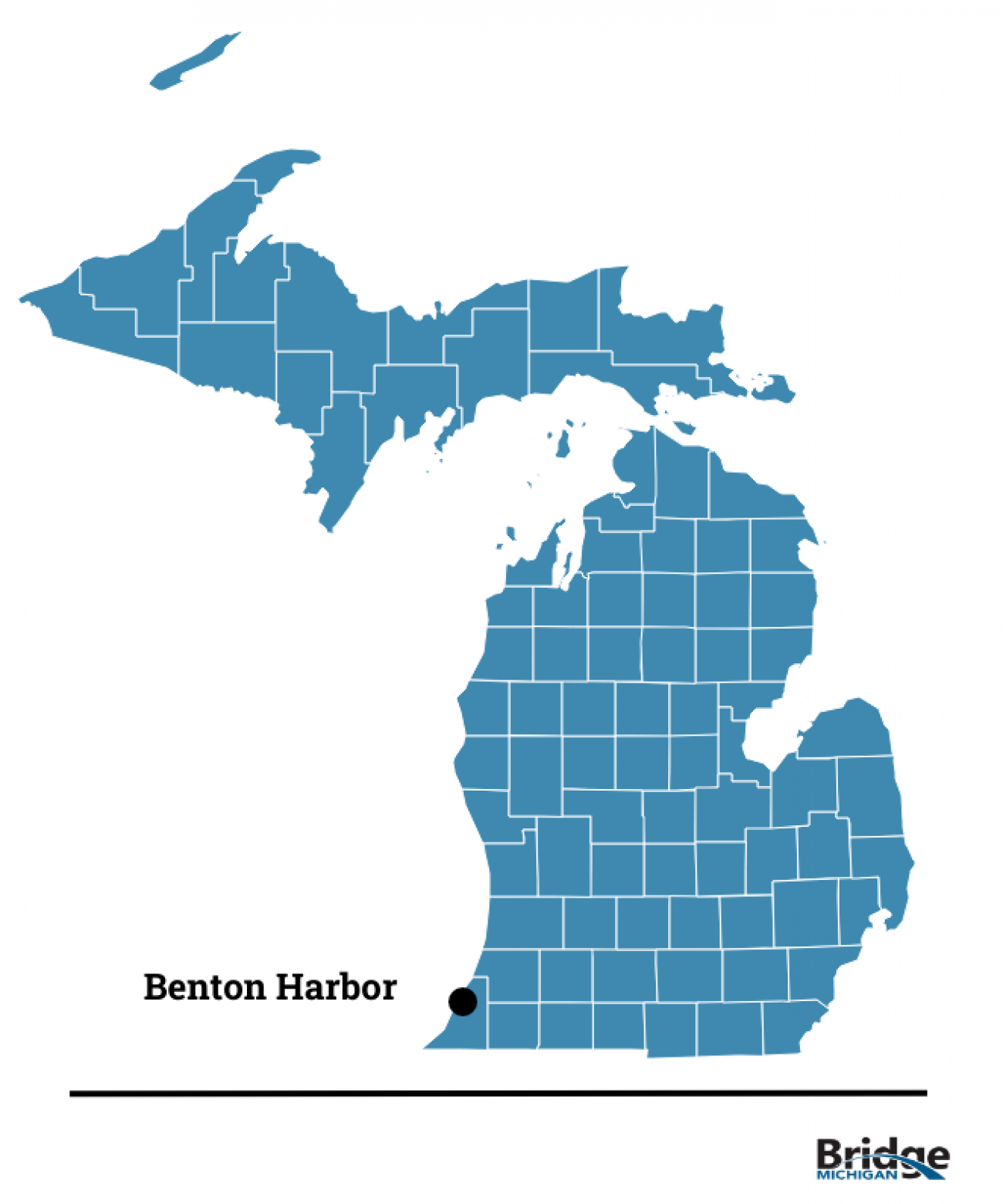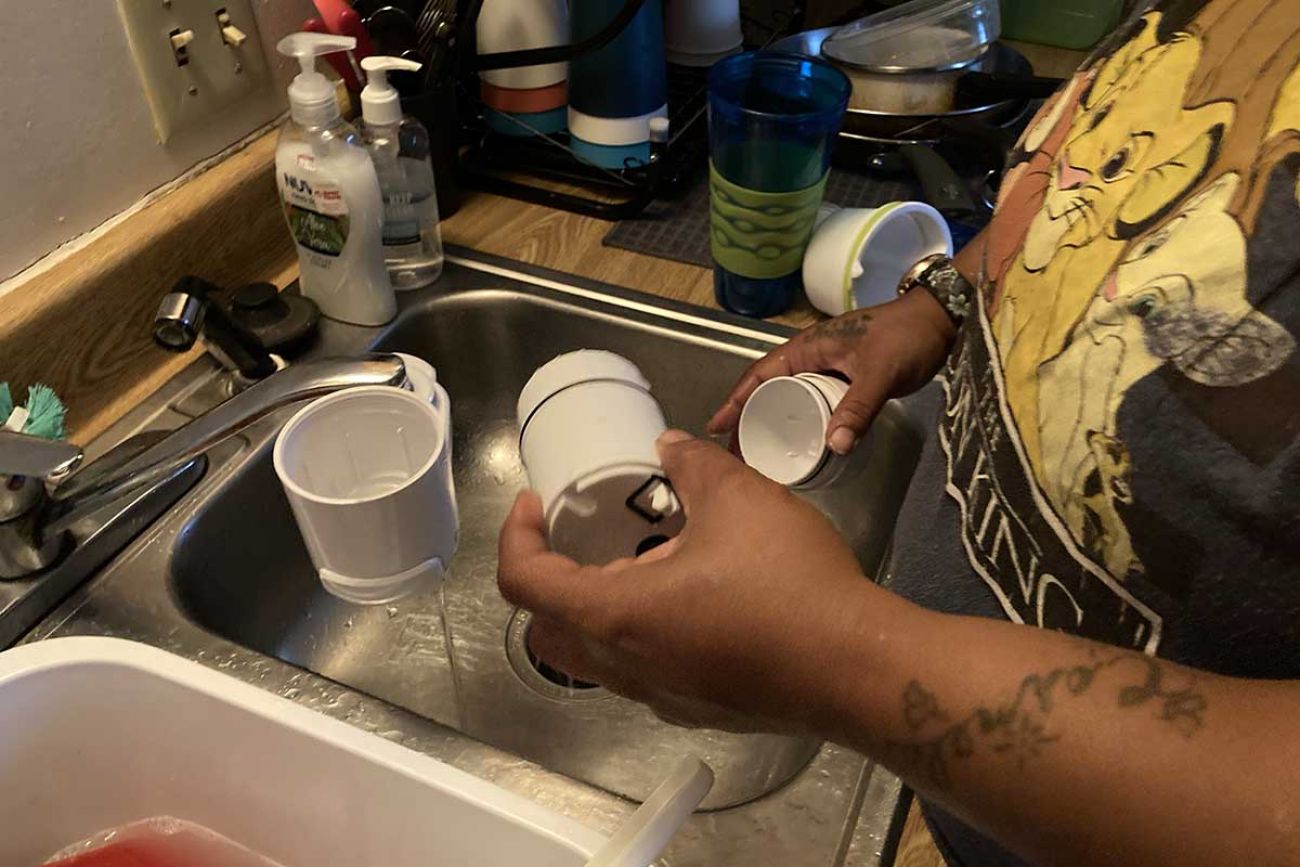In Benton Harbor, residents’ complaints of lead-tainted water carry echoes

Oct. 21: ‘What changed?’ Lawmakers press Whitmer admin on Benton Harbor’s water
Oct. 19: Michigan Legislature launches probe into Benton Harbor water crisis
Update: Michigan announces 18-month goal to remove Benton Harbor lead water lines
BENTON HARBOR—When Carmela Patton moved into her Benton Harbor home from a nearby apartment complex, she didn’t think twice about turning on the faucet to boil noodles or get a drink.
Only late last year, after her pastor recruited her to participate in a water quality sampling program, did she learn the city was in the midst of a water contamination crisis.
Water samples from Benton Harbor homes since 2018 consistently revealed elevated levels of lead, a potent neurotoxin that damages the brain and nervous system and is particularly dangerous to young children.
Related:
- As drought grips American West, irrigation becomes a Michigan selling point
- Toilet water is fouling Michigan’s water. State eyes loans to fix septics.
- Should Michigan, other states let nature clean up oil spills?
She stopped drinking the water then, and rightly so, she said: Samples collected from her faucet would later show a lead level above 700 parts per billion. That’s 47 times the federal Environmental Protection Agency’s “action level,” though no amount of lead is considered safe.
So when state leaders this week advised Benton Harbor residents to drink only bottled water — a stark escalation of the government response three years into Benton Harbor’s lead-in-water crisis — Patton was unimpressed.
“It’s a long time coming,” she said. “Why not earlier? Why just now?”
The new message from the state comes nearly a month after local activists joined a host of state and national groups to file an emergency petition with the EPA asking federal regulators to intervene in Benton Harbor, citing concerns that a lackluster response from state and local regulators was putting residents at risk.
In the weeks since, state leaders have allocated funding to replace Benton Harbor’s lead service lines far faster and say they’re redoubling efforts to ensure everyone in Benton Harbor is aware of the risk and equipped with working water filters.
That’s good news, local water activist Rev. Edward Pinkney told Bridge Michigan on Wednesday, but “it shouldn’t have taken a petition to get the ball rolling.”

And, he said, he still wants a full-throated declaration from the state that Benton Harbor’s water isn’t safe to drink.
Yellow water. A caving roof.
The lead contamination that emerged in 2018 was one more hit for this majority-black city of 9,103 people with a 45-percent poverty rate, located in a deeply segregated region near southern Lake Michigan.
Benton Harbor had just emerged from six years under oversight by a state-appointed emergency manager in response to the city’s budget deficit. Amid the financial woes, its water system saw its fair share of troubles even before the lead problems emerged.

Months ahead of the ominous test results, state regulators had flagged the city’s water system for a range of deficiencies. The water plant’s roof was caving in. The supply line that pulls water from Lake Michigan was crumbling.
“We were dealing with some pretty systemic issues,” said Eric Oswald, director of drinking water and environmental health for the Michigan Department of Environment, Great Lakes and Energy (EGLE).
The Flint water crisis that preceded it — in which a state-appointed emergency manager authorized a switch of the city’s water source without requiring the anti-corrosion chemicals to prevent lead from leaching from aging pipes — generated national attention to the threat posed by lead pipes that deliver water into households.
By the time Benton Harbor tested its water in 2018, there were other echoes of the disaster that unfolded in Flint. Local residents had begun to complain about yellow and foul water coming out of their taps, said Pinkney, who leads the Benton Harbor Community Water Council.
Subsequent test results showed a big spike: Eight of 30 homes tested had lead levels exceeding the regulatory threshold of 15 parts per billion.
That put the city well beyond the regulatory trigger for problematic lead levels in water. Communities are flagged when 10 percent or more of samples collected exceed that threshold.
Unlike in Flint, though, nothing discernable had changed about the city’s water source. Benton Harbor, like virtually all towns near Lake Michigan, draws its water from the lake. Water managers had made no tweaks to the way they treated the water before delivering it to residents.
It’s unclear what caused lead levels to suddenly spike in city testing. Oswald, of EGLE, said the best guess is that something changed about the way Benton Harbor was collecting residential water samples.
Lead levels can fluctuate from home to home based on the type of public plumbing outside the home and fixtures indoors, Oswald said. A new operator who assumed oversight of the plant in 2017, Michael O’Malley, may have changed the way homes were selected for testing.

“Those can lead to increased lead releases, simply by where you're picking your sampling sites,” he said. But O’Malley didn’t provide EGLE with addresses of the homes sampled, making it difficult to test that theory.
That could mean that lead was in those residents’ water before it was first detected in 2018. But that too, Oswald said, is impossible to know for sure.
The state has since revoked O’Malley’s certification and the city is contracting with an outside firm, F&V Operations and Resource Management, to run the water system.
But Elin Warn Betanzo, a water engineer and former EPA official who now runs the firm Safe Water Engineering, told Bridge Michigan there is another possible culprit: Benton Harbor’s water system had lost customers in recent years after neighboring communities left the system to get their water elsewhere.
Water rates spiked to offset the customer loss and pay for needed repairs, leaving some in Benton Harbor struggling to pay bills. Benton Harbor has also lost more than 900 residents in the past decade, further reducing use of its water system.
Loss of customers leaves a system with less demand, and less water flushing through delivery pipes. Betanzo said water left sitting in pipes is more likely to absorb lead. That, coupled with the operational problems at the treatment plant, she said, could have caused lead levels to spike.
EGLE officials said they don’t have reason to believe reduced demand was to blame for the high readings. But at this point, Oswald said, “you can only speculate” on the cause.
But that left Patton, the resident, wondering how long she and her neighbors may have been drinking lead-tainted water before anybody noticed. She grew up here. When she was pregnant with her now-19- and 7-year-old daughters, she followed doctors’ advice to stay hydrated.
Now, at age 43, Patton can’t help but wonder about the source of her 19-year-old’s developmental challenges: “Did drinking lead have something to do with it?”
Three years of red flags
Childhood blood lead statistics began creeping up in surrounding Berrien County around the same time that lead showed up in higher levels in Benton Harbor water tests. Last year, 3.8 percent of children tested in the county had elevated lead levels, the second straight year of increases after bottoming out at 2.5 percent in 2018.
Elizabeth Hertel, director of the Michigan Department of Health and Human Services, said it’s unclear whether those statistics could be connected to the city water’s higher lead levels. The leading cause of childhood lead exposure is lead-based paint, and childhood lead screening has lagged across Michigan during the COVID-19 pandemic.
“We’re always concerned,” Hertel said, “when we’re seeing children’s blood levels increasing anywhere.”
Testing is available through the local health department and at InterCare Family Health Network.
Following the high lead reading, city water operators began treating the water with chemicals designed to keep lead from leaching from pipes, and the state began providing residents with filters to strip lead away as water flows from the faucet.
But Rev. Pinkney argues local health officials who helped distribute the filters failed to ensure residents knew how to properly install and operate them. And because they didn’t go door-to-door to deliver filters and demonstrate installation, he said, many people in Benton Harbor continued to drink straight from the tap.
“You can’t just hand people a filter and expect everyone to know how to use it,” he said. “It’s unacceptable.”
Meanwhile, the city plodded forward with efforts to remove lead service lines from the city’s system — something the state has now required every public water provider in Michigan to do over the next two decades.
Local water providers are expected to foot the bill for that work, making it a tough proposition for financially-struggling communities like Benton Harbor, which also often have older homes and plumbing, making them more likely to have lots of lead pipes. Mayor Marcus Muhammad told Bridge that about 40 lines have been replaced so far in a city with nearly 5,900 service lines, a pace the mayor says couldn’t be helped.
“The problem didn’t just pop up out of the toaster,” Muhammad said. “It costs money to replace (pipes). So to look at the city of Benton Harbor and the local government and say ‘Why didn't they do something,’...that’s really not fair.”
Then came the second, third, fourth, fifth rounds of tests over the ensuing two years, showing lead levels above the state limit.
EGLE officials worked with Benton Harbor to secure a $5.6 million EPA grant announced in October to speed up lead line replacement while water managers tweaked formulas for the anti-corrosion chemicals.
Activists have questioned the efficacy of the chemical mix being used in Benton Harbor. Oswald of EGLE said it appears to be generally lowering lead levels, though some test results still remain dangerously high.
During the most recent round of testing in August, 11 of 78 sampled homes tested above the action threshold of 15 ppb. One hit 889, though EGLE officials said that extremely high reading came from water that had been sitting in the home’s fixtures, not the city’s water supply.
It was Benton Harbor’s sixth straight failed test.
Weeks later, Whitmer proposed sending $20 million in state funds to put Benton Harbor on a five-year timeline to eliminate its lead pipes.
By this point, community activists were fed up with what they considered an inadequately urgent response to the danger. Working with state and national organizations, they filed a petition with the U.S. Environmental Protection Agency, asking the agency to provide an “immediate emergency supply of safe drinking water” along with other remedies.
Only after that did the state begin providing bottled water to residents and announce a “renewed door-to-door effort” to distribute filters. Whitmer and legislators recently struck a budget deal giving Benton Harbor’s pipe replacement efforts a $10 million boost — half of Whitmer’s original proposal.
Finally this week, the state advised residents to drink, cook and brush their teeth with only bottled water for the foreseeable future, while the EPA does tests to determine whether the filters in Benton Harbor are sufficiently stripping lead from the water.
That decision follows concerns from the Natural Resources Defense Council and other environmental and advocacy groups about the efficacy of filters used in Benton Harbor. They cite an instance in Newark where the local water chemistry made it possible for some lead to make it past filters.
“If you cannot demonstrate that the filters are effective, it is all about bottled water,” said Cyndi Roper, the group’s senior Michigan advocate.
State and federal officials maintain confidence in the filters, calling the bottled water a precaution pending results of the EPA study. It’s not clear how long the study will take, meaning Benton Harbor residents could be on bottled water for some time.
“Certified filters that are properly installed and maintained are very effective in reducing lead concentrations in drinking water, according to the most recent science and studies,” an EPA spokesperson told Bridge in a statement.
Beyond assurances that their filters work, Benton Harbor residents say they want the lead gone, and fast.
Michigan’s 20-year deadline to replace the state’s lead pipes was nation-leading when the state passed it in 2018 in the aftermath of Flint. But since then, New Jersey has set a 10-year deadline. And after activists sued over Newark’s high lead levels, the city replaced every lead service line in the city in two years.
Most, if not nearly all, of Benton Harbor’s 5,877 service lines will need replacement.
EGLE officials told Bridge Michigan they’re working with Benton Harbor to expedite lead line replacement now that new money is available, but an aggressive timeline would take at least another 18 to 24 months.
Complicating the matter, Oswald said, is that many Benton Harbor homes have lead in their internal plumbing fixtures.
The state requires water providers to sample both the first and fifth liter of water coming from the tap to get a sense of lead levels in both internal plumbing and public service lines. Oswald said recent rounds of testing have shown lead levels from service lines declining, while in-home lead levels remain high.
During the most recent sampling period, EGLE spokesperson Hugh McDiarmid said, the three highest hits all came from first liter samples.
State officials say they are now seeking money to also replace lead-containing faucets inside residents’ homes.
‘It shouldn’t take a crisis’
Lead service lines are common in Michigan, with at least some residents in communities across the state getting their water from them.
Water providers were banned from installing them in 1986, meaning that communities with older housing stock are more likely to have lead lines.
The Michigan Municipal League has estimated there are as many as 500,000 lead lines in Michigan, with a price tag as high as $2.5 billion to replace them all. In some places, nearly everyone is connected to a lead line. Lead plumbing fixtures are also disturbingly common.
Residents in many communities where lead levels aren’t high enough to trigger state action are still likely drinking some amount of lead. Michigan’s current 15 ppb threshold is set to lower to 12 ppb in 2025. If that standard was in place now, an additional 16 Michigan communities would have failed the most recent round of tests.
“We need a mandate across the country to get all of the lead pipes out of the ground,” said Roper of the Natural Resources Defense Council, calling lead lines buried across the state “ticking time bombs.”
Some Michigan communities are pondering using a portion of their COVID-19 relief dollars to get ahead on that work, said John LaMacchia of the Michigan Municipal League. And spending proposals from Whitmer and Republican legislative leaders include money for lead pipe replacement. The infrastructure bill pending in Congress would target lead lines as well.
But for now those are merely proposals. Pinkney, whose community only received the cash to eliminate lead lines after it became clear residents were drinking tainted water, said Benton Harbor should serve as a lesson to lawmakers:
“It shouldn’t take a crisis,” Pinkney said, “to fix the problem.”
Benton Harbor’s next round of water samples due in December.
Michigan Environment Watch
Michigan Environment Watch examines how public policy, industry, and other factors interact with the state’s trove of natural resources.
- See full coverage
- Subscribe
- Share tips and questions with Bridge environment reporter Kelly House
Michigan Environment Watch is made possible by generous financial support from:
Our generous Environment Watch underwriters encourage Bridge Michigan readers to also support civic journalism by becoming Bridge members. Please consider joining today.
See what new members are saying about why they donated to Bridge Michigan:
- “In order for this information to be accurate and unbiased it must be underwritten by its readers, not by special interests.” - Larry S.
- “Not many other media sources report on the topics Bridge does.” - Susan B.
- “Your journalism is outstanding and rare these days.” - Mark S.
If you want to ensure the future of nonpartisan, nonprofit Michigan journalism, please become a member today. You, too, will be asked why you donated and maybe we'll feature your quote next time!






